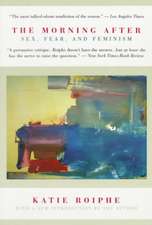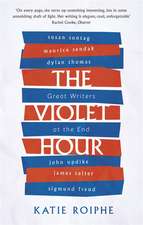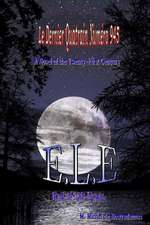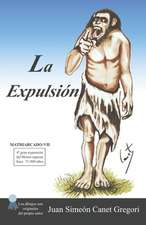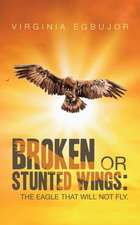Still She Haunts Me
Autor Katie Roipheen Limba Engleză Paperback – 30 sep 2002
Dodgson met Alice in 1856, when she was almost four years old. Eventually he would capture her in his photographs, and transform the stories he told her into the luminous Alice’s Adventures in Wonderland & Through the Looking-Glass. Then, suddenly, when Alice was eleven, the Liddell family shut him out, and his relationship with Alice ended abruptly. The pages from Dodgson’s diary that may have explained the rift have disappeared.
In imagining what might have happened, Katie Roiphe has created a deep, textured portrait of Alice and Dodgson: she changing from an unruly child to a bewitching adolescent, and he, a diffident, neurasthenic adult whose increasing obsession with her almost destroys him. Here, too, is a brilliantly realized cast of characters that surround them: Lorina Liddell, Alice’s mother, who loves her daughter even as she envies her youth; Edith Liddell, Alice’s resentful little sister; and James Hunt, Dodgson’s speech therapist, an island of sanity in Dodgson’s increasingly chaotic world.
Preț: 87.21 lei
Nou
Puncte Express: 131
Preț estimativ în valută:
16.69€ • 17.84$ • 13.91£
16.69€ • 17.84$ • 13.91£
Carte tipărită la comandă
Livrare economică 17 aprilie-01 mai
Preluare comenzi: 021 569.72.76
Specificații
ISBN-13: 9780385335300
ISBN-10: 038533530X
Pagini: 240
Dimensiuni: 140 x 213 x 20 mm
Greutate: 0.25 kg
Editura: DELTA
ISBN-10: 038533530X
Pagini: 240
Dimensiuni: 140 x 213 x 20 mm
Greutate: 0.25 kg
Editura: DELTA
Notă biografică
Katie Roiphe received her Ph.D. from Princeton in English literature. Her articles have appeared in The New York Times, The Washington Post, Esquire, Harper’s, and The New Yorker, among many others. Her previous books are The Morning After and Last Night in Paradise. She lives in New York City.
From the Hardcover edition.
From the Hardcover edition.
Extras
The sky was yellow gray that first day. Drifting past them were ragged dark clouds with bright burning edges. Dodgson and an old friend, Reginald Southey, were carrying their cameras and equipment to the cathedral. Southey had long hair tucked behind his ears and the swarthy coloring of a sailor, even though he was studying to be a physician. Dodgson had recently photographed him with his arm draped around the shoulder of a skeleton, to capture his good-natured morbidity. The casual, friendly approach medical men took toward death.
The two men carried with them the portable dark tent with its yellow calico curtain, a tripod, bottles, trays, glass measures and funnels. Dodgson had just bought his camera for fifteen pounds a month earlier, from T. Ottiwell of Charlotte Street, and it was still heavy and awkward in his hands.
The afternoon light was silvery, the tower of the cathedral dulled by glowing fog. It would lift though, Dodgson was fairly sure as he looked up at the sky. He began unpacking the heavy metal tripod, setting up the tent that would serve as a makeshift darkroom, uncorking the brown bottle of collodion, and pouring the strong-smelling nitrate solution into a tray. The two men began framing photographs. Formal landscapes were what they were after, stiffly posed portraits of building and sky.
Dodgson loved the spires and towers of the university, the overlapping grays, the chipped and mottled stone over green sprays of wild grass. He loved the large, circular pool in the middle of Tom Quad, the round symmetrical sensibleness of it, black water reflecting broken cloud. Christ Church felt like a fortress to him, peaceful and protected and entirely isolated. Time moved differently here; it hovered and clung.
Still, the new dean was intent on changing the physical face of the university, stripping the dark oak paneling from inside the cathedral, for instance. But unlike most of the other young lecturers, Dodgson resisted. He liked the ancient, unchangeable solidity, the perpetually disintegrating aspect of the place that somehow hinted at the impossibility of it ever truly falling apart. He liked the arched doorways and low-ceilinged halls, the loom and coolness at once churchy and castlelike.
Dodgson put his camera down. His hands were sticky from collodion. He wiped them with a cloth he had tucked into his pocket. And then brought the camera back to his face.
Everything that flickered could be made permanent. That was what drew him to photography, what made every painstaking step worth it the permanence of the image. That was what fascinated him, the working against time; the black art, it was called, which did have the power to stop the visual progression, the disintegration of the moment into a worse one the bird that would fly off the branch.
He and Southey stood on the edge of the deanery lawn. Through the rosewood camera he could see the sun slowly burning though the fog. Then a patch of blue. The cathedral shadowed in triangles, hexagons, and rectangles. He aimed at the cathedral, cutting off the tiny fluttering leaves in order to include the spire and then cutting off the spire in order to frame the building with tiny fluttering leaves, and then stumbling backward holding the camera. He loved the precision, the small slice of shadow under each leaf, that came across in photographs, in perfect, almost scientific detail.
Southey was off to the side concentrating on the garden.
“Have a look,” he said, stepping aside for Dodgson to see.
There through the viewfinder in the deanery garden was a tall dark-haired woman in a chocolate brown dress, which was billowing slightly in the wind.
They moved closer. Dodgson took her in through the lens, black hair pulled back from her face in scalloped waves, pale, luminous skin, fine lines fanning out around her eyes, not detracting at all from her prettiness but instead giving sadness and depth to her strange, sharply angled face, which had the odd dimensional perspective of a Renaissance portrait. Her most striking feature by far was her mouth, her large pillowy lips. They saved her face from looking cool. There was no doubt that she was beautiful.
“There is a likeness I should not mind taking,” Southey said.
The woman turned toward the two young men on the edge of her lawn and waved.
“Won’t you come and have ginger beer with us?” she called out.
“It would be our pleasure,” called Southey.
She seemed barely old enough to be the wife of the dean, barely thirty, if that.
Behind her were three girls, dark and pretty like their mother, playing croquet. Or rather the two oldest were playing croquet and the youngest, who could not have been more than two, was tilting unsteadily toward the wickets and grabbing them. A pear-shaped woman with yellow hair was standing in the shade. She must be the nurse, Dodgson thought to himself.
Dodgson watched the youngest careen. Amazing how oblivious children are to their own bodies. He watched her fall.
“I’m Reginald Southey,” said Southey.
Dodgson stood there. He felt a familiar wave of panic.
“And this is Charles Dodgson.”
“You must be the new mathematical lecturer”, she said, smiling. “We have so wanted to make your acquaintance.”
“Yes, I have seen you before, but.” He flushed. “I was hoping to meet you. The whole family.”
“And I hope you have come with the express intention of taking our likenesses,” she said.
“N-n-nothing would make me happier.”
“These are my daughters,” she said, gesturing toward the girls. Lorina, Alice, Edith.
Dodgson turned toward the girls. Southey barely glanced at them. Like most men his age Southey had a studied indifference to children, which was meant to point out his independence and enhance his virility. But Dodgson had always liked children. Or as he once put it in a letter to a friend, “I’m fond of children (except boys).”
“So you are studying medicine,” Mrs. Liddell was saying to Southey.
“Yes, dabbling with skeletons.”
Dodgson shaded his eyes so he could see better. The girls were running across the lawn, batting the ball, their skirts flying behind them.
His eye was drawn to the middle one. Alice. The least pretty. Not an inanimate doll-beauty like the others, but a dark, wild, tousled thing. Her legs and arms too long, sunbrowned, her hair short for a girl, almost boyish, and messy, sticking up, as if she had just woken up, the front cut unevenly; no doubt she squirmed under the scissors. Her face was pointed. Her eyes enormous and complicated and black.
And then there was the slightest trace of theater in her stance. She ran a little too fast. She concentrated a little too intently on the ball. She swung a little too hard when she hit it. All of which served to make her more there than her sisters.
The oldest, Lorina, fished under a hedge for the ball. Alice turned to stare in a way he had never seen a child stare. The darkness of her eyes and arch of her eyebrows gave her an expression of cool skepticism entirely incongruous in someone her age.
“Isn’t it awful, all of that sawing living creatures apart?” Mrs. Liddell was saying.
“I am afraid most of us actually enjoy it,” Southey said.
Alice was oddly foreign-looking for the middle of Oxford. Next to her sisters, ordinary, British, pale-skinned, ruddy-cheeked, well-fed, it was striking how different she looked. The other two were like paler versions of her, white where Alice was nut-colored, soft and round where Alice was sharp. If they were photographs, they would be blurred, overexposed versions of their more radiant sister. Or so it seemed to Dodgson.
Mrs. Liddell patted back a stray curl that had blown loose in the wind. She looked out at the game. Dodgson saw a slight tightening of her smile when her eyes rested on her middle daughter, a watchfulness that did not descend on the other two.
“Do have some ginger beer,” Mrs. Liddell said, pouring two glasses.
The men, one short, one tall, were standing with her mother against the lime-colored grass. The sun was in her eyes. Shimmering diamonds between leaves. White dots on the inside of her eyelids when she blinked. She could feel the men watching her. She stuck out her stomach.
A blue ball spun hard into the arch of Dodgson’s foot.
He looked down and moved his shoe.
“I’m sorry,” Alice said, running up to him. “But I believe it’s your turn.”
She held up the mallet with both hands.
He stooped to take it.
“This is the new mathematical lecturer, Alice,” said Mrs. Liddell.
“Are you going to lecture me?”
Mrs. Liddell watched Dodgson wander off into the game with her poised and disheveled middle daughter, whose bow, she noticed, was lopsided and coming untied. He seemed shy, standing there without saying anything for so long, taking in a child’s croquet game like it was the ceiling of the Sistine Chapel.
She watched her four-year-old daughter running through the lawn, her hair blue-black in the sun, pulling the tall young man by the hand.
While Lorina Liddell often furnished her children’s futures, down to the addresses in London, wallpaper, and china patterns, she had trouble with Alice. She couldn’t imagine how her unruly daughter was going to fit into the exalted society she had always planned for her children, the dinner tables packed with dukes and ladies and famous novelists and cabinet members.
Her own insecurities clustered around the single issue of social origin. William Thackeray, who was a classmate of Henry Liddell, wrote to a mutual friend when the Liddells married: “Dear brave old Liddell ... has taken a 3rd rate provincial lady (rather first rate in the beauty line, though, I think) for a wife.” Though the nineteen-year-old Lorina Hannah Liddell could not have known about this remark, she woke up the morning after her wedding with the uneasy feeling that this exact sentiment was being discussed over breakfast by remote acquaintances. After all, the dean’s mother’s uncle was the brother of the eighth earl of Strathmore, and his father’s father was a baronet. The new Mrs. Liddell worried that in spite of her cashmere burnoose with tassels, and sable-trimmed pelisse, and her blue satin with lace and rose-trimmed flounces, her 3rd rate provincialism showed.
Is your family having a portrait painted? their Oxford friend Mrs. Lamb once asked Alice. You look so unusually neat. Mrs. Liddell couldn’t hide her annoyance when the comment was repeated to her. But she couldn’t deny that Alice was perpetually in disarray. Once there was a mat in the back of her hair so daunting, so difficult to untangle, that they were forced to cut out a hunk of hair, which made the thin bristling remainder in the back of her neck impossible to smooth down. She was embarrassed that her middle daughter should seem so uncared for, even though she lived in a perfectly ordered house, even though both of her sisters managed to keep perfectly reasonable heads of hair. They had long ago given up trying to get her hair to hold any sort of curl. Her hair was soft and fine and straight, not at all the sort of hair that should be difficult to care for, and yet it was. Which only made it worse that her clothes were often stained, wrinkled, crumpled, or undone, shedding buttons, trailing sashes, losing hems. Or that mysterious bruises were constantly emerging, in yellows and purples, on her arms and legs. There was no reason, no tangible moment when her appearance started unraveling; it just happened naturally when she stepped out of the house to play for five minutes, or even if she didn’t. Mrs. Liddell was endlessly bothered by her middle daughter’s dishevelment, but there was nothing she could do, no amount of vigilance, no amount of forcing her to stay still, that would stop the natural progression of disorder.
Dodgson stepped carefully over a wicket with Alice’s hand in his. A man and a girl. A man and his idea of a girl. Lifted out of poems like Wordsworth’s “We Are Seven.” The poet writes about a curly-haired eight-year-old who insists that there are seven children in her family even though two of them are dead. She doesn’t understand that death has made them five. That is the girl Dodgson was looking for. The girl of his dreams. She takes her supper out to her brother and sister’s graves and sits crosslegged in the grass, not out of innocence exactly, but a kind of stubbornness. The first that died was sister Jane; In bed she moaning lay. The poem has a frantic undercurrent, barely suppressed and contained. Till God released her of her pain; And then she went away. She knows. She doesn’t want to know. The result is a kind of play, but it is more than play, it is an overturning of death, an ability to sit and eat your dinner over it, because the mind is that strong and flexible. Seven minus two is not five. The fierceness of imagination required to produce that thought is what Dodgson found so charming in little girls. That is what it meant to him, the old romantic saw that children are close to God, that the dust of creation is still on them. That is what innocence is, the word that dances and eludes: it is the refusal of death.
Dodgson felt the wind in his face as he walked next to Alice. He felt hope opening up over the expanse of croquet wickets. Like a picnic over graves.
The two men carried with them the portable dark tent with its yellow calico curtain, a tripod, bottles, trays, glass measures and funnels. Dodgson had just bought his camera for fifteen pounds a month earlier, from T. Ottiwell of Charlotte Street, and it was still heavy and awkward in his hands.
The afternoon light was silvery, the tower of the cathedral dulled by glowing fog. It would lift though, Dodgson was fairly sure as he looked up at the sky. He began unpacking the heavy metal tripod, setting up the tent that would serve as a makeshift darkroom, uncorking the brown bottle of collodion, and pouring the strong-smelling nitrate solution into a tray. The two men began framing photographs. Formal landscapes were what they were after, stiffly posed portraits of building and sky.
Dodgson loved the spires and towers of the university, the overlapping grays, the chipped and mottled stone over green sprays of wild grass. He loved the large, circular pool in the middle of Tom Quad, the round symmetrical sensibleness of it, black water reflecting broken cloud. Christ Church felt like a fortress to him, peaceful and protected and entirely isolated. Time moved differently here; it hovered and clung.
Still, the new dean was intent on changing the physical face of the university, stripping the dark oak paneling from inside the cathedral, for instance. But unlike most of the other young lecturers, Dodgson resisted. He liked the ancient, unchangeable solidity, the perpetually disintegrating aspect of the place that somehow hinted at the impossibility of it ever truly falling apart. He liked the arched doorways and low-ceilinged halls, the loom and coolness at once churchy and castlelike.
Dodgson put his camera down. His hands were sticky from collodion. He wiped them with a cloth he had tucked into his pocket. And then brought the camera back to his face.
Everything that flickered could be made permanent. That was what drew him to photography, what made every painstaking step worth it the permanence of the image. That was what fascinated him, the working against time; the black art, it was called, which did have the power to stop the visual progression, the disintegration of the moment into a worse one the bird that would fly off the branch.
He and Southey stood on the edge of the deanery lawn. Through the rosewood camera he could see the sun slowly burning though the fog. Then a patch of blue. The cathedral shadowed in triangles, hexagons, and rectangles. He aimed at the cathedral, cutting off the tiny fluttering leaves in order to include the spire and then cutting off the spire in order to frame the building with tiny fluttering leaves, and then stumbling backward holding the camera. He loved the precision, the small slice of shadow under each leaf, that came across in photographs, in perfect, almost scientific detail.
Southey was off to the side concentrating on the garden.
“Have a look,” he said, stepping aside for Dodgson to see.
There through the viewfinder in the deanery garden was a tall dark-haired woman in a chocolate brown dress, which was billowing slightly in the wind.
They moved closer. Dodgson took her in through the lens, black hair pulled back from her face in scalloped waves, pale, luminous skin, fine lines fanning out around her eyes, not detracting at all from her prettiness but instead giving sadness and depth to her strange, sharply angled face, which had the odd dimensional perspective of a Renaissance portrait. Her most striking feature by far was her mouth, her large pillowy lips. They saved her face from looking cool. There was no doubt that she was beautiful.
“There is a likeness I should not mind taking,” Southey said.
The woman turned toward the two young men on the edge of her lawn and waved.
“Won’t you come and have ginger beer with us?” she called out.
“It would be our pleasure,” called Southey.
She seemed barely old enough to be the wife of the dean, barely thirty, if that.
Behind her were three girls, dark and pretty like their mother, playing croquet. Or rather the two oldest were playing croquet and the youngest, who could not have been more than two, was tilting unsteadily toward the wickets and grabbing them. A pear-shaped woman with yellow hair was standing in the shade. She must be the nurse, Dodgson thought to himself.
Dodgson watched the youngest careen. Amazing how oblivious children are to their own bodies. He watched her fall.
“I’m Reginald Southey,” said Southey.
Dodgson stood there. He felt a familiar wave of panic.
“And this is Charles Dodgson.”
“You must be the new mathematical lecturer”, she said, smiling. “We have so wanted to make your acquaintance.”
“Yes, I have seen you before, but.” He flushed. “I was hoping to meet you. The whole family.”
“And I hope you have come with the express intention of taking our likenesses,” she said.
“N-n-nothing would make me happier.”
“These are my daughters,” she said, gesturing toward the girls. Lorina, Alice, Edith.
Dodgson turned toward the girls. Southey barely glanced at them. Like most men his age Southey had a studied indifference to children, which was meant to point out his independence and enhance his virility. But Dodgson had always liked children. Or as he once put it in a letter to a friend, “I’m fond of children (except boys).”
“So you are studying medicine,” Mrs. Liddell was saying to Southey.
“Yes, dabbling with skeletons.”
Dodgson shaded his eyes so he could see better. The girls were running across the lawn, batting the ball, their skirts flying behind them.
His eye was drawn to the middle one. Alice. The least pretty. Not an inanimate doll-beauty like the others, but a dark, wild, tousled thing. Her legs and arms too long, sunbrowned, her hair short for a girl, almost boyish, and messy, sticking up, as if she had just woken up, the front cut unevenly; no doubt she squirmed under the scissors. Her face was pointed. Her eyes enormous and complicated and black.
And then there was the slightest trace of theater in her stance. She ran a little too fast. She concentrated a little too intently on the ball. She swung a little too hard when she hit it. All of which served to make her more there than her sisters.
The oldest, Lorina, fished under a hedge for the ball. Alice turned to stare in a way he had never seen a child stare. The darkness of her eyes and arch of her eyebrows gave her an expression of cool skepticism entirely incongruous in someone her age.
“Isn’t it awful, all of that sawing living creatures apart?” Mrs. Liddell was saying.
“I am afraid most of us actually enjoy it,” Southey said.
Alice was oddly foreign-looking for the middle of Oxford. Next to her sisters, ordinary, British, pale-skinned, ruddy-cheeked, well-fed, it was striking how different she looked. The other two were like paler versions of her, white where Alice was nut-colored, soft and round where Alice was sharp. If they were photographs, they would be blurred, overexposed versions of their more radiant sister. Or so it seemed to Dodgson.
Mrs. Liddell patted back a stray curl that had blown loose in the wind. She looked out at the game. Dodgson saw a slight tightening of her smile when her eyes rested on her middle daughter, a watchfulness that did not descend on the other two.
“Do have some ginger beer,” Mrs. Liddell said, pouring two glasses.
The men, one short, one tall, were standing with her mother against the lime-colored grass. The sun was in her eyes. Shimmering diamonds between leaves. White dots on the inside of her eyelids when she blinked. She could feel the men watching her. She stuck out her stomach.
A blue ball spun hard into the arch of Dodgson’s foot.
He looked down and moved his shoe.
“I’m sorry,” Alice said, running up to him. “But I believe it’s your turn.”
She held up the mallet with both hands.
He stooped to take it.
“This is the new mathematical lecturer, Alice,” said Mrs. Liddell.
“Are you going to lecture me?”
Mrs. Liddell watched Dodgson wander off into the game with her poised and disheveled middle daughter, whose bow, she noticed, was lopsided and coming untied. He seemed shy, standing there without saying anything for so long, taking in a child’s croquet game like it was the ceiling of the Sistine Chapel.
She watched her four-year-old daughter running through the lawn, her hair blue-black in the sun, pulling the tall young man by the hand.
While Lorina Liddell often furnished her children’s futures, down to the addresses in London, wallpaper, and china patterns, she had trouble with Alice. She couldn’t imagine how her unruly daughter was going to fit into the exalted society she had always planned for her children, the dinner tables packed with dukes and ladies and famous novelists and cabinet members.
Her own insecurities clustered around the single issue of social origin. William Thackeray, who was a classmate of Henry Liddell, wrote to a mutual friend when the Liddells married: “Dear brave old Liddell ... has taken a 3rd rate provincial lady (rather first rate in the beauty line, though, I think) for a wife.” Though the nineteen-year-old Lorina Hannah Liddell could not have known about this remark, she woke up the morning after her wedding with the uneasy feeling that this exact sentiment was being discussed over breakfast by remote acquaintances. After all, the dean’s mother’s uncle was the brother of the eighth earl of Strathmore, and his father’s father was a baronet. The new Mrs. Liddell worried that in spite of her cashmere burnoose with tassels, and sable-trimmed pelisse, and her blue satin with lace and rose-trimmed flounces, her 3rd rate provincialism showed.
Is your family having a portrait painted? their Oxford friend Mrs. Lamb once asked Alice. You look so unusually neat. Mrs. Liddell couldn’t hide her annoyance when the comment was repeated to her. But she couldn’t deny that Alice was perpetually in disarray. Once there was a mat in the back of her hair so daunting, so difficult to untangle, that they were forced to cut out a hunk of hair, which made the thin bristling remainder in the back of her neck impossible to smooth down. She was embarrassed that her middle daughter should seem so uncared for, even though she lived in a perfectly ordered house, even though both of her sisters managed to keep perfectly reasonable heads of hair. They had long ago given up trying to get her hair to hold any sort of curl. Her hair was soft and fine and straight, not at all the sort of hair that should be difficult to care for, and yet it was. Which only made it worse that her clothes were often stained, wrinkled, crumpled, or undone, shedding buttons, trailing sashes, losing hems. Or that mysterious bruises were constantly emerging, in yellows and purples, on her arms and legs. There was no reason, no tangible moment when her appearance started unraveling; it just happened naturally when she stepped out of the house to play for five minutes, or even if she didn’t. Mrs. Liddell was endlessly bothered by her middle daughter’s dishevelment, but there was nothing she could do, no amount of vigilance, no amount of forcing her to stay still, that would stop the natural progression of disorder.
Dodgson stepped carefully over a wicket with Alice’s hand in his. A man and a girl. A man and his idea of a girl. Lifted out of poems like Wordsworth’s “We Are Seven.” The poet writes about a curly-haired eight-year-old who insists that there are seven children in her family even though two of them are dead. She doesn’t understand that death has made them five. That is the girl Dodgson was looking for. The girl of his dreams. She takes her supper out to her brother and sister’s graves and sits crosslegged in the grass, not out of innocence exactly, but a kind of stubbornness. The first that died was sister Jane; In bed she moaning lay. The poem has a frantic undercurrent, barely suppressed and contained. Till God released her of her pain; And then she went away. She knows. She doesn’t want to know. The result is a kind of play, but it is more than play, it is an overturning of death, an ability to sit and eat your dinner over it, because the mind is that strong and flexible. Seven minus two is not five. The fierceness of imagination required to produce that thought is what Dodgson found so charming in little girls. That is what it meant to him, the old romantic saw that children are close to God, that the dust of creation is still on them. That is what innocence is, the word that dances and eludes: it is the refusal of death.
Dodgson felt the wind in his face as he walked next to Alice. He felt hope opening up over the expanse of croquet wickets. Like a picnic over graves.
Recenzii
“A love story in gothic blues...Its algebraic elegance casts a sweeping light on the surreal and cruel elements of the ‘Alice’ books, allowing us to read, as it were, between the lines.”—Los Angeles Times
“Rich and inspired...[An] ambitious and engaging piece of fiction.”—Chicago Tribune
“Rich and inspired...[An] ambitious and engaging piece of fiction.”—Chicago Tribune
Descriere
Charles Lutwidge Dodgson, a shy Oxford mathematician, used the name Lewis Carroll and wrote two classics that liberated children's literature from Victorian moralism. But the nature of his relationship with his young muse, Alice Liddell, remains mysterious. In imagining what might have happened Roiphe has created a deep, richly textured fictional portrait of Alice and Dodgson.

